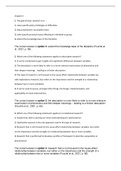Chapter 4
1. The goal of basic research is to …
1) solve specific policy challenges or difficulties.
2) help practitioners accomplish tasks.
3) solve specific practical issues affecting an individual or group.
4) extend the knowledge base of the discipline.
The correct answer is option 4: extend the knowledge base of the discipline (Fouché et
al., 2021, p. 58).
2. Which one of the following statements applies to descriptive research?
1) It can be conducted to gain insights into significant differences between variables.
2) The description is more likely to refer to a more intensive examination of phenomena and
their deeper meanings – leading to a thicker description.
3) This type of research is not focused on the cause-effect relationship between variables (as
with explanatory research), but rather on the importance and the strength of a relationship
between two or more variables).
4) It can be used to assess, amongst other things, the design, implementation, and
applicability of social interventions.
The correct answer is option 2: the description is more likely to refer to a more intensive
examination of phenomena and their deeper meanings – leading to a thicker description
(Fouché et al., 2021, p. 65).
3. Which one of the following statements applies to correlational research?
1) Studies that seek to develop an initial understanding of a phenomenon.
2) Qualitative research is the only approach used in this type of research.
3) Research that is not focused on the cause-effect relationship between variables, but rather
on the importance and the strength of a relationship between two or more variables.
4) Research that is performed to develop a profile or framework to describe a population or
phenomenon.
The correct answer is option 3: research that is not focused on the cause-effect
relationship between variables, but rather on the importance and the strength of a
relationship between two or more variables (Fouché et al., 2021, p. 66).
, 4. The purpose of a literature review is NOT to …
1) select the units of analysis, such as individuals, groups, organisations, programmes or
social artifacts.
2) familiarise yourself with the current state of knowledge regarding the research problem.
3) learn how others have delineated similar problems; and review how the phenomenon has
been researched to enable sensitivity to conceptual and methodological pitfalls.
4) focus on establishing a defensible rationale for the study and the chosen research
approach; and highlight relevant knowledge gaps that merit investigation.
The correct answer is option 1: select the units of analysis, such as individuals, groups,
organisations, programmes or social artifacts (Fouché et al., 2021, p. 67).
Chapter 5
5. Which one of the following statements is not a primary purpose of the research proposal?
1) To document precisely what research questions will be addressed or what specific
hypotheses will be investigated.
2) To justify the choice of a topic with regard to contemporary literature, its theoretical or
conceptual basis and the potential relevance of its findings, and show how the proposed
study is situated in the larger knowledge pool.
3) To implement the sampling, data collection, data analyses, and interpretation.
4) To demonstrate to the reviewers or funders that the study is grounded in literature and
anchored within a theoretical or a conceptual framework, that it is methodologically
sound and practically and achievably organised, and that it will make a meaningful
contribution to the knowledge base of the profession and/or deliver measurable outcomes
or benefits.
The correct answer is option 3: to implement the sampling, data collection, data
analyses, and interpretation (Fouché et al., 2021, pp. 75-76).
6. The introduction or contextualisation of the study should not ...
1) be like a funnel in that it starts broadly and moves to a more specific focus of the study.
The funnel would ideally involve a progression from more general to more specific
issues, culminating in the purpose of the study.




